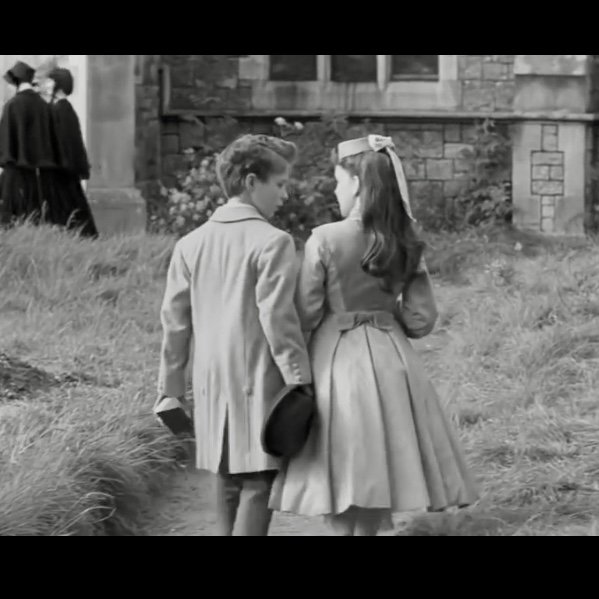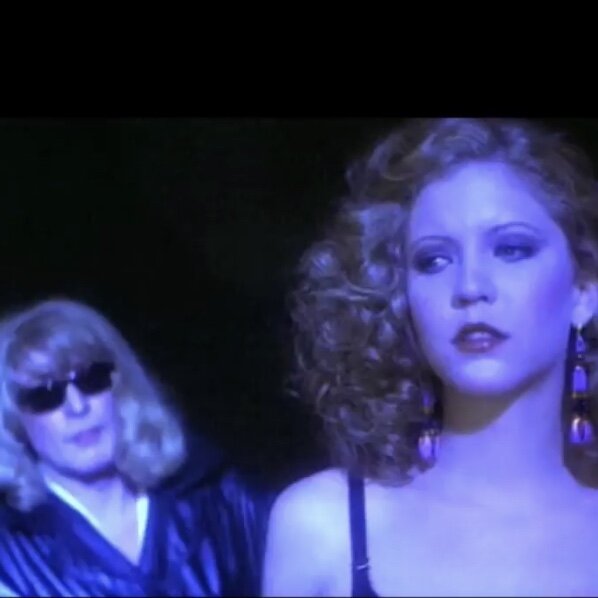“Secretive; Whispery; Indecent”: Intentional Disconnect in 1961’s The Innocents
More gothic folklore than gruesome gore, Jack Clayton’s beautifully haunting (and hauntingly beautiful) 1961 film, The Innocents is high-art psychological horror. Co-written by William Archibald and Truman Capote, the film is based on the 1898 Henry James story, The Turn of the Screw.
Deborah Kerr stars as Miss Giddens, a governess hired to care for two children, Flora (Pamela Franklin) and Miles (Martin Stephens), at an English manor. An unsettling tone is set right from the beginning: Behind the initial screen blackness, pre-opening credits, the sound of a young girl (Flora) singing “O Willow Waly” creates a disturbing blurred line between wholesome lullaby and its mournful lament for a lost lover. The disconnect continues through the opening credits, now with birds chirping in the darkness; those familiar tweets most often heard at daybreak, instead of in the dead of night. And finally, a profile of a distressed Miss Giddens, clutching her hands together, tilting her head back with her eyes closed, her forehead glistening with perspiration; the sight of sweat common in the blazing sunlight, not in the glowing moonlight.
Day or Fright
Throughout the crisp, black-and-white film there are a number of bone-chilling scenes. The manor and its grounds become settings for strange goings-on, ones not solely reserved for the nighttime, when fatigue, shadows and imagination can get the best of someone, but in broad daylight as well, often with others nearby. But what is real, and who is credible? In the film’s first line, a sense of doubt is immediately placed upon the viewer toward Miss Giddens, when the children’s uncle asks her during the interview for the governess position: “Do you have an imagination?” An almost embarrassed Giddens replies with a yes. As the film progresses: To believe or not to believe her, that becomes the subsequent question in the viewer’s mind.
Depth of Fear
The crisp black and white mentioned earlier is the work of the cinematographer, Freddie Francis, who used a deep-focus technique, which allows the foreground, middle ground and background to be equally sharp. One of the best examples is when Flora becomes oddly excited about nature’s brutality. She declares: “Oh look, it’s a lovely spider, and it’s eating a butterfly!” (Spiders aren’t usually described as lovely, creating another example of intentional disconnect.) The large depth of field simultaneously creates distance and claustrophobia for the viewer (a visual disconnect), while also establishing Flora as the spider to Miss Giddens as the butterfly.
Brother and Sinister
In addition to this macabre outlook on nature, mature subtexts run throughout, particularly ones dealing with the misguided affection between Miles and Miss Giddens. After learning more about two of the manor’s previous residents, Giddens begins to suspect the prim, proper, poetic Miles, and the once-sweet now emotionally hysterical, Flora are not who they appear to be, that something evil has entered the innocent (foreshadowed when Giddens admires a stone cherub in the garden, only for a cockroach to crawl out of its mouth).
Giddens conveys to Mrs. Grose, the housekeeper enveloped by extreme denial, that both children “are playing, or being made to play, some monstrous game. I can’t pretend to understand what its purpose is; I only know that it is happening: something secretive, and whispery, and indecent.” (Undoubtedly, Capote-penned prose.)
The relationship between Miles and Flora becomes suspect as well. Flora seems to have a psychic connection to Miles, knowing when Miles will return home from his school, permanently dismissed for bad behavior, even before Miss Giddens or Mrs. Grose. Giddens becomes watchful of the two siblings as they hold hands, walking closely together toward the town church. A concerned Giddens says to Mrs. Grose: “Look at them. What do you think they’re saying?… They’re talking about them; talking horrors.”
And the horrors continue through the film’s dizzying conclusion (or disturbing connection to its beginning, as described earlier), one that is both spine-tingling and heavyhearted, where the secretive becomes communicative, the whispery reaches its crescendo, the indecent once again innocent.
Double Trouble: Reflections on Brian De Palma’s Dressed to Kill
Brian De Palma’s Dressed to Kill is his (graphic) homage to Alfred Hitchcock’s 1960 classic, Psycho: Here’s a list of the some of the referential elements:
De Palma’s film incorporates not one, but two shower scenes;
Its female lead, Kate Miller (Angie Dickinson is to Janet Leigh’s Marion Crane; both characters essentially good women “gone bad”) is the “Hitchcock blond”;
Instead of a shower curtain, an elevator door is the temporary barrier that separates victim from killer, safety from harm, life from death;
Nancy Allen (is to Vera Miles) and Keith Gordon (is to John Gavin) step in as crime solvers;
Allen with a “tall blond” behind her and flickering lightning is to Miles with Anthony Perkins and a swinging lightbulb;
A psychiatrist (David Margulies to Simon Oakland) summarizes personality conflict, arousal and the human psyche.
Sunglasses At Night: Liz (Nancy Allen) and the “tall blond.”
Filmways Pictures. Cinematographer: Ralf D. Bode.
Also take note of duality as a running theme: Spoilers ahead: Besides De Palma’s signature split-screen technique, his script includes a scene where Michael Caine’s Dr. Elliott is on the phone in his office, taking the time to spell out his last name: “E; double l; i; o; double t,” plus there are a number of scenes involving mirrors: Elliot becoming startled when he catches his reflection in a mirror, with another occurrence shown in the trailer below; when Allen’s character, a call girl named Liz, seduces Elliott during a therapy session, he glances down to a mirror on his desk, and smirks devilishly. The audience also learns near the end of the film that there are two “tall blonds,” one with good intentions, the other, as already previously noted.
Although De Palma is certainly influenced by the Master of Suspense, he still manages to add his own visual stamps and a dreamy score by Pino Donaggio to create an enduring film that feels anything but a carbon copy.
Watch “Hitchcock,” and Watch Hitch Watch
The classic film, Psycho recently turned 60. Here’s a review of the 2012 film, Hitchcock:
“Why do they keep looking for new ones, when they still have the original?” Just one of the questions uttered by the true Master of Suspense, Alfred Hitchcock (Anthony Hopkins) in the film, Hitchcock, directed by Sacha Gervasi. Based on Stephen Rebello’s book, Alfred Hitchcock and the Making of Psycho, the film traces the period after North By Northwest. The old adage of “You’re only as good as your last picture” starts to peck at the director, due, in part, to skepticism that Hitch could keep his streak going, especially at age 60.
Looking for his next project, Hitch and his trusted advisors, his wife and professional collaborator, Alma Reville (Helen Mirren) and assistant, Peggy Robertson (Toni Collette) search high and low for something that will stop those bent on looking for a new Master. Hitch discovers Robert Bloch’s book, Psycho, based on the life of the Wisconsin serial killer, Ed Gein. Not only having an appetite for sneaking drink and paté de foie gras, Hitch’s appetite for something unexpected needs satiating, and thus this question is posed to Alma: “What if someone really good made a horror picture?” Against all good sense, according to just about everyone around him—press; studio heads; even an initially reluctant Alma—he persists with the professional and monetary risk that is Psycho. The actress Janet Leigh (Scarlett Johansson) is cast to play the “bird,” Marion “Crane”; the actor Anthony Perkins (James D’Arcy) Norman Bates; the actress Vera Miles (Jessica Biel) Marion Crane’s sister, Lila.
Anthony Hopkins is credible and holds Hitch’s deep, garbled, slow-paced delivery, even saying quite convincingly the classic deadpan salutation, “Good evening,” made famous by Hitch as he welcomed viewers to his television series, “Alfred Hitchcock Presents.” Yet when Hitch, on set, directs Leigh in the scene from Psycho, where Marion is nervously driving her car, Hopkins’ vocal delivery slips, intentionally perhaps? One can’t help but hear the voice of Hannibal Lecter, Hopkins’ definitive role in The Silence of the Lambs.
Sound Familiar?
Hopkins - Hannibal - Hitchcock.
Orion Pictures. Cinematographer: Tak Fujimoto.
In Lambs, just as Lecter taunts Agent Starling during their first meeting, mocking in a southern drawl her “pure West Virginia” upbringing, speculating about her father being a “coal miner” and “how quickly the boys found you…sticky fumblings in the backseats of cars…,” Hitch taunts Leigh, calling Marion, “Daddy’s perfect little angel” and making reference to Marion’s “…sticky little lunchtime trysts with that oh-so-handsome failure Mr. Samuel Loomis.” Thankfully, the filmed highway on the screen behind the stunt car skips, causing Hopkins, now vocally back as Hitch, to stop the filming. Hitch then storms behind the blank screen, which casts his iconic silhouette, a self-referential silo added into most of his films.
Always in the Shadows
The iconic Hitchcock silhouette, as seen here in 1976’s Family Plot.
Universal Pictures. Cinematographer: Leonard J. South.
There’s also another predominant reference throughout Hitchcock. The Director of Photography, Jeff Cronenweth manages to frame shots that present several visual references to birds, creating a sense of foreshadowing to what would become Hitch’s next picture after Psycho, the aptly coined, The Birds.
Note:
Paintings on Hitch and Alma’s bathroom and bedroom walls.
The lampshade in the house library.
A silhouette of a bird over Hitch’s shoulder as he peers out through a set of blinds at Alma and her friend, Whit.
Bird sculptures on a liquor cabinet in Hitch’s studio office.
Birds flying low over the ocean as Alma and Whit talk on the beach.
A reference to birds in this John J. McLaughlin–penned screenplay: Vera Miles was contracted to do one more film for the notoriously involved, “he’s-always-watching” Hitch. As Biel’s Miles is changing in her dressing room, she says: “One more picture and I am free as a bird.”
Oh, Flock!
After Psycho came The Birds.
Universal Pictures. Cinematographer: Robert Burks.
The relationship between Miles and Hitch is also briefly explored. Hitch all but ignores Miles on set, and we later discover why; his focus is on Leigh, yet another fantasy blond, a style with which the director was famously enamored. Miles goes so far as to offer some cautionary advice to Leigh, after Leigh endures Dr. Lecter’s, I mean, Hitch’s relentless taunting. Hitchcock definitely highlights Hitch’s obsession with his work, and perhaps through speculation and creative license, the viewer is able to see just how consumed—voluntarily or involuntarily—he could be with his subject matter, no matter how dark and sinister. Disappointment by women play out often as well, providing a glimpse into Hitch’s sensitivity to feeling abandoned, so much so, extreme control at any cost was exuded.
On a related note, the film, rightly so, focuses equally on wife/mother figure, Alma, spotlighting how important professional collaboration and personal support are to the birth of a creative project, and in the case of Psycho, how the absence of this union could have easily resulted in something “stillborn.” Together, Master and Mistress of Suspense became the proud parents of, arguably, the best thriller in film history.











